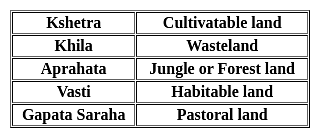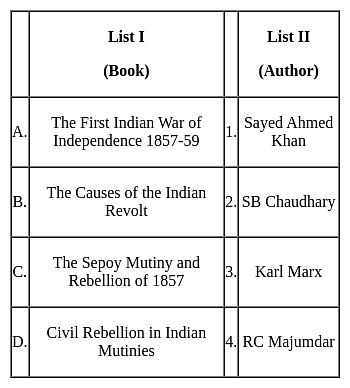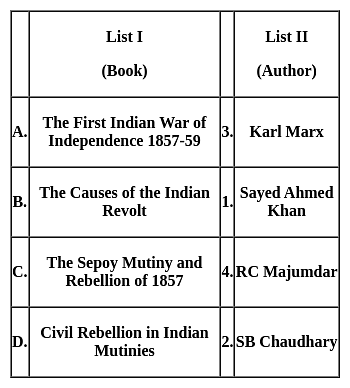TS SET Paper 2 Mock Test - 9 (History) - TS TET MCQ
30 Questions MCQ Test TS SET Mock Test Series 2024 - TS SET Paper 2 Mock Test - 9 (History)
Consider the following statements about Cripps Mission:
1. It offered the setting up of a constituent assembly after the war where mainly Indians would decide the constitution.
2. The British government would accept the constitution only if the princely states agreed to it.
3. Members of this assembly would be partly elected by the provincial assemblies through proportional representation and partly nominated by the princes.
Which of the above statement(s) is/are correct?
With reference to the history of ancient India, consider the following statements:
1. Rajendra I defeated the Kalabhras and established the Pallava rule in Tondaimandalam.
2. Bharavi, the great poet who wrote the famous Kiratrjuniya, was patronized by Pallavas.
Which of the statements given above is/ are correct?
| 1 Crore+ students have signed up on EduRev. Have you? Download the App |
Consider the following statements, with reference to the Magadha empire.
- Warriors and priests, i.e., the Kshatriyas and the Brahmanas, were exempted from the payment of taxes.
- Bali became a compulsory payment to be made by the peasants in the age of Buddha.
Choose the correct statement.
Consider the following statements regarding the INA Trials:
1. A resolution was adopted by the Indian National Congress declaring support for the prisoners under the INA trials.
2. Defense in the support of INA prisoners in the Court was taken up by Jawaharlal Nehru and Tej Bahadur Sapru.
3. The Loyalists appealed to the Government to abandon the trials for good Indo-British relations.
Which of the statements given above are correct?
With reference to the states that emerged with the decline of the Mughals, consider the following statements:
1. Most of these states adopted the Mughal style of administration.
2. The politics of these states were invariably communal.
3. The rulers of these states succeeded in mitigating the economic crisis that emerged in the late 17th century.
4. The position of peasants in these states continued to deteriorate.
Which of the following statements given above is/are correct?
Who is the writer of the book “Kitab-Ul-Hind”?
Consider the following statements about the provisions of the C. Rajagopalachari Formula:
1. Muslim League to endorse Congress's demand for independence.
2. Only the Muslims of North-West and North-East to vote in the plebiscite and not the entire population, in case of partition.
3. In case of acceptance of partition, agreement to be made jointly for safeguarding defense, commerce, communications, etc.
Which of the above statement(s) is/are correct?
Who was the first President of the All India Trade Union Congress established in 1920?
Balathal is an archaeological site located in:
Which of the following is the correct order of the Vedic literature?
Consider the following pairs:
- Ajanta cave: Buddhist in theme
- Ellora cave: Hinduism in theme
Which of the pairs given above is/are correct?
Consider the following statements about Mountbatten Plan:
1. Punjab and Bengal Legislative Assemblies would meet in two groups, Hindus and Muslims, to vote for partition. If a simple majority of either group voted for partition, then these provinces would be partitioned.
2. Referendums in NWFP and Sylhet district of Bengal would decide the fate of these areas.
3. Independence for princely states ruled out, they would join either India or Pakistan.
Which of the above statements are correct?
Which one of the following buildings is known as ‘Shan-i-Fatehpur’?
Which act during British India provided financial grant for encouragement of Indian literature and promotion of science?
With reference to the land classification of the Gupta period, consider the following pairs:

Which of the pairs given above is/are correctly matched?
Choose the incorrect pair.
1) Heer Ranjha:- composed by Shah Abdul Latif
2) Tayaumanavar:- composed by Warris Shah
3) Risalo:- exponent of sittar poetry
Consider the following statements with reference to the Gupta period.
1. The Gupta period is known for the remarkable production of secular literature.
2. It also saw the development of Buddhist and Jain literature written in Sanskrit.
Which above statements is/are correct?Which of the following tourist places is known as ‘pilgrimage of sculpture'?
Consider the following statements regarding the Industrial Policy Resolution of 1948?
(1) 3 Fold classification of Industries.
(2) Public sector industries were called Key Industries
Select the correct answer using the code given below.Which among the following in not true regarding the grievances of the sepoys in East India Company's Army?
In which year there was a mutiny by the sepoys at Vellore due to the replacement of the turban they wore, by a leather cockade.
Consider the following statements regarding Butler Committee:
1. The Butler Committee was set up to examine the nature of the relationship between the princely states and government.
2. Butler commission recommended that States should be handed over to an Indian Government in British India
Which of the statements given above is/are correct?Lord Dalhousie was appointed as the Governor-general of India in which year?
Which of the following statement is/are correct?
- Akbar II granted the title of 'Raja' to the famous social and cultural reformer Ram Mohan Roy.
- Akbar II is credited with starting the Hindu-Muslim unity festival Phool Walon Ki Sair.
- Akbar had little de facto power due to the increasing British influence in India through the East India Company.
- Akbar Shah II reigned from 1805 to 1857.
Select the correct code from below.
Which of the following were reasons for the emergence of the left-wing within the congress in the late British Era?
1. There was a group of young leaders like Jawaharlal Nehru and Bose who were influenced by the outside world and the ideological developments there.
2. Socialist ideas acquired roots in the Indian soil and socialism became the accepted creed of Indian youth.
3. Impact of the Russian Revolution, wherein Lenin overthrew the despotic Czarist regime and declared the formation of the first socialist state.
Select the right code from the code given below.
Which of the following is true in the context of 'East India Company '?
A. In 1690, the East India Company acquired a charter from the ruler of England, Queen Elizabeth II.
B. With this charter the Company ventured across new lands from which it bought goods at a cheap price, and carry them back to Europe to sell at higher prices
C. The royal charter prevented other European powers from entering the Eastern markets.
D. Vasco da Gama an English explorer discovered this sea route to India in 1498.
Which of the following is associated with Megaliths?
|
60 tests
|




















